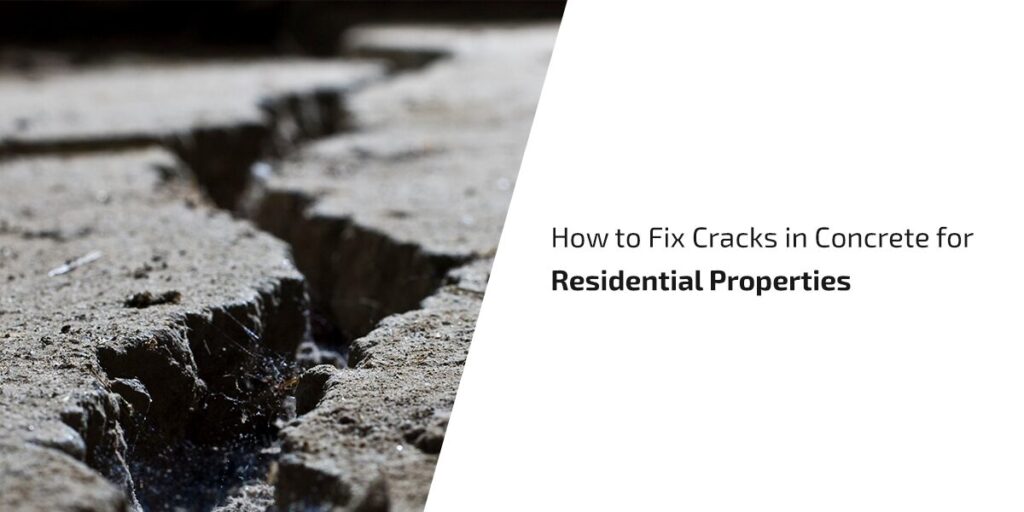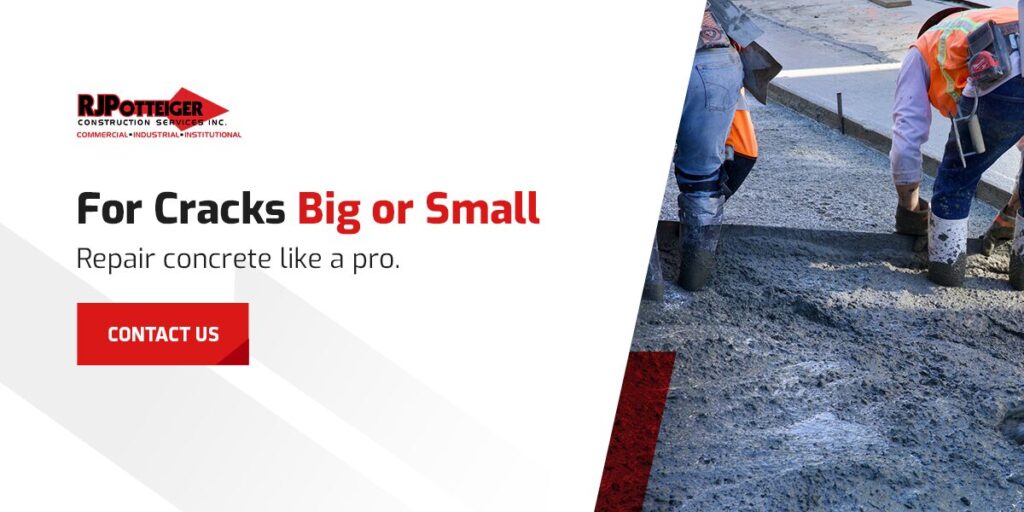How to Fix Cracks in Concrete for Residential Properties

Concrete is tough, but it can still crack. And finding a crack on your concrete slab’s surface is a nuisance. A simple, hairline crack can be an eyesore, whereas a wider, uneven crack can signal a more expensive problem. It’s best to fix the problem before it becomes a growing concern.
This article outlines a step-by-step DIY tutorial to repair concrete cracks. Whether you’re learning how to repair cracks in a concrete driveway or tackling a garage floor, this guide will help you understand the process. Know which tools and materials are needed and how to identify the difference between a cosmetic and serious crack. Learn when it’s best to call a pro with key warning signs.
Types of Concrete Cracks
Before you start fixing cracks in concrete, it’s important to identify the type of crack you’re dealing with. Some cracks are superficial and easy to handle yourself, whereas others are more serious and may require professional help. Concrete cracks can be categorized into two main types.
Nonstructural Cracks
Nonstructural cement cracks are superficial, meaning they do not affect your building’s structural integrity. These cracks’ width can vary, but they tend to be narrower and shallower. They’re generally less than 3 millimeters (about 1/8 inch). You also get hairline cracks that are extremely thin — like a strand of hair — that are under 1.5 millimeters (about 1/16 inch) wide. Their risk is generally low, but should be monitored as they can expand.
Structural Cracks
Structural cement cracks are more serious as they threaten a building’s structural stability and integrity. Although they can vary in appearance, they tend to be wider than cosmetic cracks. They also pose a higher risk, especially if left unaddressed.
Tools and Materials for Concrete Crack Repair
For a successful concrete floor crack repair, gather the necessary tools and materials before starting the project.
Tools
You’ll need the following tools:
- Safety glasses
- Gloves
- Dust mask
- Screwdriver
- Wire brush
- Vacuum
- Hammer and chisel
- Masonry trowel or putty knife
- Blower or air compressor (optional)
- Crack chasing blade (optional)
Materials
The most essential material for minor, nonstructural crack repair is a concrete filler or sealant. Using the right cement to fix cracks is key for a long-lasting repair. The best choice depends on the crack’s size and location. Your options include:
- Epoxy sealant.
- Polyurethane sealant.
- Liquid cement crack filler.
- Vinyl-reinforced concrete patcher.
You may also consider backer rods for deeper cracks.
How to Fix Minor, Nonstructural Concrete Cracks
Whether the crack is on a driveway, garage or sidewalk, you can use this simple four-step process to fix cracks in concrete.

1. Prepare the Crack
When sealing cracks in a driveway, ensure the surface is prepped and clean for the best results. Proper preparation helps the filler adhere better to form a strong bond within the crack, facilitating the repair’s durability and longevity.
For smaller, surface-type cracks, you’ll need to perform a crack chase. This process involves routing out and widening the crack to about 1/4 inch before filling it. The goal is to create a clean, V-shaped groove to provide more surface area for the filler or sealant to stick to. You can do this by hand with a chisel and hammer, or use a crack chasing blade with an angle grinder to speed up the process.
Next, clean up any debris from the crack by loosening it with a screwdriver or a wire brush. You’ll want a tool that can get deep into the crack to ensure each piece of dirt is gone. Alternatively, an air compressor or blower can make this process much faster by blowing the debris out. Remember to vacuum everything up afterward. If the crack is wide enough from the beginning, you just have to clean it.
2. Apply the Filler
Take your patching compound of choice and use it according to its manufacturer’s directions. Most patching compounds will come in a bottle. You’ll typically have to cut the nozzle tip at an angle to match the crack’s width. You can then apply the filler within the crack from beginning to end. You’ll want to apply enough to slightly overfill the crack to allow for some settling.
If the crack is too deep and you don’t want to use too much filler, consider pressing backer rods into the crack. Backer rods are small, round pieces of foam that allow you to fill as much of the crack as possible. Wedge the rods into the crack, at least an inch below the surface, using a screwdriver. Once inserted, you can apply the filler.
3. Level the Surface
Immediately after applying the patching compound, you need to level the surface. You can use a masonry trowel, putty knife or even a wet finger to smooth the filler so it’s flush with the surrounding concrete.
4. Dry the Patch
Lastly, allow the compound to fully dry. During the drying process, water or solvents will evaporate, hardening the patch as time passes. Hardening time can vary based on the product and conditions, but generally ranges from 24 to 48 hours. Note that there is a difference between concrete curing and drying, although they’re used interchangeably.
When to DIY vs. Call a Pro
Not all foundational cracks are created equal. Some can be easily fixed, whereas others need professional attention.
Fix It Yourself
If you have the required tools and materials and are confident in your skills, you can fix a cracked concrete slab yourself. DIY repairs are usually suitable for:
- Small hairline cracks, less than 1/4 inch.
- Superficial cracks.
- Stable cracks.
Call a Professional
In some cases, a crack is more than just an eyesore, but a structural issue. Contact a concrete professional if you notice the following signs:
- Wide cracks
- Deep cracks
- Uneven cracks
- Growing cracks
- Recurring cracks
- Extensive damage
Concrete Repair FAQs
Refer to the frequently asked questions for more information.
How Much Does Concrete Crack Repair Cost?
Concrete repair costs depend on how big the crack is and who’s fixing it. DIY projects may cost between $10 and $100, depending on the tools and materials needed. Professional repairs may cost up to $1,000 or more, depending on the severity of the crack. However, you can have peace of mind that specialists are handling the repair.
Should I Use Epoxy or Polyurethane Filler?
While epoxy and polyurethane fillers are both effective for crack repairs, they serve different purposes. Use epoxy filler for structural, dry cracks where strength is important, such as foundations or load-bearing repairs. Use polyurethane fillers for leaking, moving or hairline cracks where flexibility and waterproofing are needed, such as driveways and patios.
When Is the Best Time of Year to Repair Concrete?
The best time of year to repair concrete is during spring or early fall. The mild temperatures are ideal for curing and drying, aiding in strength and longevity. Also, these seasons have a lower risk of extreme weather, such as heavy rains or freezing cold, which could impact the quality of the repair.
How Long Does It Take for Concrete to Cure?
Concrete can take between 24 and 48 hours to harden enough for light traffic. Note that curing is a different process that helps strengthen the repair. Concrete can take up to 28 days to fully cure.
For Cracks Big or Small, Get a Professional Opinion
While minor cracks are manageable as DIY projects, structural issues require professional intervention to ensure the safety and integrity of your property. At R. J. Potteiger Construction Services, Inc., we understand that home projects can be overwhelming. That’s why we strive to make them as simple as possible with comprehensive residential concrete services, from driveways to patios.
Repairing concrete cracks is what we do best. That’s why with us, you get thorough project assessments paired with quality, timely workmanship. As a fully licensed concrete construction company, you can have peace of mind that we can handle any crack, no matter how big or small.
Contact us today for a detailed concrete crack repair estimate.




